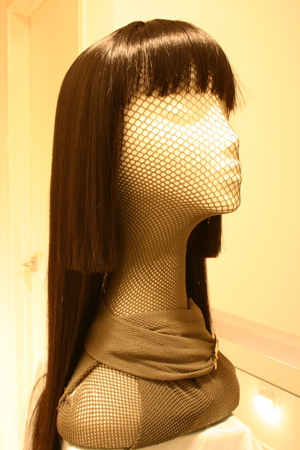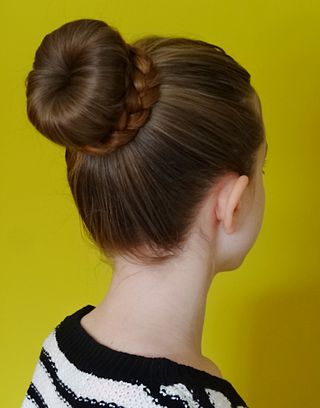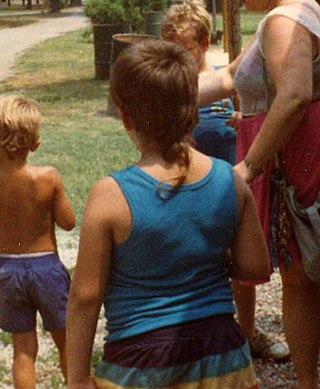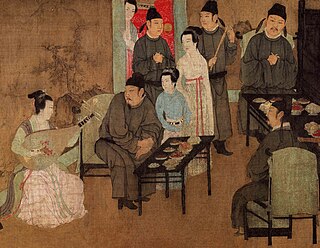
A hairstyle, hairdo, haircut or coiffure refers to the styling of hair, usually on the human head but sometimes on the face or body. The fashioning of hair can be considered an aspect of personal grooming, fashion, and cosmetics, although practical, cultural, and popular considerations also influence some hairstyles.

A wig is a head covering made from human or animal hair, or a synthetic imitation thereof. The word is short for "periwig". Wigs may be worn to disguise baldness, to alter the wearer's appearance, or as part of certain professional uniforms.

The mohawk is a hairstyle in which, in the most common variety, both sides of the head are shaven, leaving a strip of noticeably longer hair in the center. Mohawk hairstyles have existed for thousands of years. As of the 21st century, they are most commonly associated with punks, or broader non-conformity.

In the context of hairstyles, the usage of the term pigtail shows considerable variation. The term may refer to a single braid, but is more frequently used in the plural ("pigtails") to refer to twin braids on opposite sides of the head. Sometimes, the term "pigtails" applies whether or not the hair is braided, but there is not widespread agreement on this.
Traction alopecia is a type of alopecia or hair loss caused by a chronic pulling force being applied to the hair. It commonly results from a person frequently wearing their hair in a particularly tight ponytail, pigtails, or braids with increased likelihood when hair is chemically relaxed as this compromises the hair shaft's tensile strength resulting in hair breakage. Traction alopecia causes a recession of the hairline due to chronic traction, which is characterized by a fringe along the marginal hairline on physical exam. Diagnosis is clinical and treatment directed at cessation of the chronic traction, while cosmeses, with surgical restoration is reserved for severe cases with scarring fibrosis.

A bun is a type of hairstyle in which the hair is pulled back from the face, twisted or plaited, and wrapped in a circular coil around itself, typically on top or back of the head or just above the neck. A bun can be secured with a hair tie, barrette, bobby pins, one or more hair sticks, a hairnet, or a pen or pencil. Hair may also be wrapped around a piece called a "rat". Alternatively, hair bun inserts, or sometimes rolled up socks, may also be used to create donut-shaped buns. Buns may be tightly gathered, or loose and more informal.

The Pigtail Ordinance was an 1873 law intended to force prisoners in San Francisco, California to have their hair cut within an inch of the scalp. It affected Qing Chinese prisoners in particular, as it meant they would have their queue, a waist-long, braided pigtail, cut off. The proposal passed by a narrow margin through the San Francisco Board of Supervisors in 1873 but was vetoed by the mayor. An identical version of the law was enacted by the California State Legislature in 1876 and was subsequently struck down as unconstitutional in 1879.

A rattail is a hair style that is characterized by a long "tail"-like element of hair growing downward from the back of the head. The rattail usually hangs naturally; however, it can be braided, treated as a dread, permed, straightened, poofed, or curled with an iron. In some instances, an individual might choose to grow several tails as opposed to a single very long tail. A rattail is characterised by hair longer than the rest of the hair surrounding it.

A queue or cue is a hairstyle worn by the Jurchen and Manchu peoples of Manchuria, and was later required to be worn by male subjects of Qing China. Hair on top of the scalp is grown long and is often braided, while the front portion of the head is shaved. The distinctive hairstyle led to its wearers being targeted during anti-Chinese riots in Australia and the United States.

A scrunchie is a fabric-covered elastic hair tie used to fasten medium to long hair types. The elastic hair tie is encased in loose fabric that forms a ruffle when twisted around a ponytail. Large, elaborate styles and diminutive, unassuming forms are available in many different colors, fabrics, and designs.

Long hair is a hairstyle where the head hair is allowed to grow to a considerable length. Exactly what constitutes long hair can change from culture to culture, or even within cultures. For example, a woman with chin-length hair in some cultures may be said to have short hair, while a man with the same length of hair in some of the same cultures would be said to have long hair.
Hanfu Movement, also known as the Hanfu Revival Movement, is a cultural movement seeking to revitalize Han Chinese fashion. That movement developed in China since 2003. Han Chinese clothing was changed drastically during the Manchu-led Qing dynasty. The Hanfu movement seeks to restore the dress and attire and aesthetic sensibilities of Han Chinese dress from previous eras recognized as high points for Han culture - principally the Ming, Tang, Song and Han.

Chinese clothing includes the traditional hanfu and garments of ethnic minorities, as well as modern variations of indigenous Chinese dresses. Chinese clothing has been shaped through its dynastic traditions, as well as through foreign influences. Chinese clothing showcases the traditional fashion sensibilities of Chinese culture traditions and forms one of the major cultural facets of Chinese civilization.

A hair ties is an item used to fasten hair, particularly long hair, away from areas such as the face. This is usually done as part of a hairstyle such as pigtails, bunches, or ponytails for straight, wavy, and loosely curled hair, and referred to as afro puffs, bunny tails, and "pineapples" for highly curled and highly textured natural hair. Two common types of hair tie are the scrunchie and the elastic. The term can also include a fixed tie or rubber band which is placed through or around strands to hold specific parts of hair together, rather than tie it or clasp them together like a hair clip.

Hanfu are the traditional styles of clothing worn by the Han Chinese. There are several representative styles of hanfu, such as the ruqun, the aoqun, the beizi and the shenyi, and the shanku.
Secular laws regulating hairstyles exist in various countries and institutions.

Liangbatou or erbatou is a hairstyle/headdress worn by Manchu women. It is a tall headdress that features two handfuls of hair, parted to each side of the head, sometimes with the addition of wire frames, extensions and ornamentation.

Braids are a complex hairstyle formed by interlacing three or more strands of hair. Braiding has been used to style and ornament human and animal hair for thousands of years in various cultures around the world.
Tifayifu was a cultural policy of the early Qing dynasty as it conquered the preceding Ming dynasty. In 1645, the Tifayifu edict forced Han Chinese people to adopt the Manchu hairstyle, the queue, and Manchu clothing. The edict specifically applied to living adult men, who did not fall in the stipulated exceptions. In 1644, on the first day when the Manchu penetrated the Great Wall of China in the Battle of Shanhai Pass, the Manchu rulers ordered the surrendering Han Chinese population to shave their heads; however, this policy was halted just a month later due to intense resistance from the Han Chinese near Beijing. Only after the Manchu captured Nanjing, the southern capital, from the Southern Ming in 1645 was the Tifayifu policy resumed and enforced severely. Within one year after entering China proper, the Qing rulers demanded that men among their newly defeated subjects adopt the Manchu hairstyle or face execution. The Qing prince regent Dorgon initially canceled the order to shave for all men in Ming territories south of the Great Wall. The full Tifayifu edict was only implemented after two Han officials from Shandong, Sun Zhixie and Li Ruolin, voluntarily shaved their foreheads and demanded that Dorgon impose the queue hairstyle on the entire population.

Qizhuang, also known as Manfu and commonly referred as Manchu clothing in English, is the traditional clothing of the Manchu people. Qizhuang in the broad sense refers to the clothing system of the Manchu people, which includes their whole system of attire used for different occasions with varying degrees of formality. The term qizhuang can also be used to refer to a type of informal dress worn by Manchu women known as chenyi, which is a one-piece long robe with no slits on either sides. In the Manchu tradition, the outerwear of both men and women includes a full-length robe with a jacket or a vest while short coats and trousers are worn as inner garments.






















